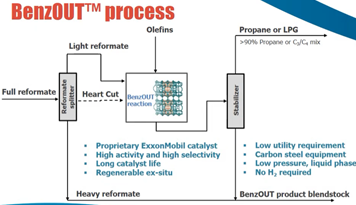IRPC Americas: BenzOUT process for benzene compliance and Octane enhancement
By Sumedha Sharma, Technical Editor, Hydrocarbon Processing
Jennifer Muir, Technology Licensing Manager, Badger Process Technology, TechnipFMC, presented an informative session on “ Octane Enhancement - BenzOUT - A commercially proven process for benzene reduction and maximum reformate octane barrels for gasoline blending” on the second day of IRPC Americas ONLINE event. She was joined in the presentation and the following Q&A session by Erik Moy, Badger Process Technology, TechnipFMC, and Terry Helton, Sr. Business Development Manager, ExxonMobil.
Jennifer described BenzOUT, their commercial process for benzene reduction and reformate octane enhancement. BenzOUT is a technology alliance between TechnipFMC’s subsidiary Badger Licensing, and ExxonMobil Catalysts and Licensing. This technology amalgamates ExxonMobil’s zeolite catalyst technology with Badger’s alkylation expertise to achieve refinery benzene compliance by removing 95% or more of Benzene in refinery streams. Benzene removal is achieved by reacting Benzene in reformate with propylene creating an alkyl-aromatic stream. Jennifer listed several other benefits of this technology, such as – Octane enhancement, reduced RVP, regained reformer flexibility, and increased gasoline yield through upgradation of refinery olefins.
Economic drivers for opting BenzOUT - Jennifer cited Benzene credit trends; and highlighted how BenzOUT can enable refiners to eliminate purchasing and instead generate Benzene credits. She also discussed the importance of octane enhancement by comparing yearly values of octane barrels.
BenzOUT beats other benzene removal technologies - Refineries use pre-reformer removal of benzene precursors to meet benzene compliance but lose significant octane barrels and reformate gasoline volume in the process. Other methods like benzene saturation use up hydrogen while producing low octane cyclohexane. Unlike its competing technologies BenzOUT does not consume Hydrogen, increases product octane, and increased gasoline volume. It also allows for any polygas or saturation reactor to be retrofit as a BenzOUT reactor, thus providing a less costly alternative.

Reactor configuration and catalyst – The reactor is typically one stage circulating, liquid phase, fixed bed reactor. The process allows for flexibility to have once-through and multi-stage reactors as well; depending upon the require conversion, benzene content, and reformate properties. The catalyst is zeolite based, highly selective, no coking, and has a high cycle life of >4years. Catalyst removal for ex-situ regeneration is simple. The reactor can use wide rage of feedstock from light reformate, heart cut reformate, to pygas and coal tar benzene. Similarly, it can process refinery/polymer grade propylene, ethylene, or even mixed olefins. The BenzOUT alkylation reaction results in high octane products such as cumene and di-isopropyl benzene (DIPB). The relative amounts of these products depend on benzene conversion and reactor staging.
Jennifer further shared success stories from current licensees of BenzOUT technology – Husky Superior LLC, Wisconsin, and Wyoming Refining Company, Wyoming. BenzOUT has successfully provided Husky and Wyoming plants an octane gain ~2 points and a benzene compliance <0.62 vol%.






Comments